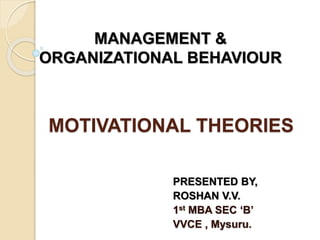MANAGEMENT AND ORGANISATIONAL BEHAVIOUR
- 1. MOTIVATIONAL THEORIES PRESENTED BY, ROSHAN V.V. 1st MBA SEC ŌĆśBŌĆÖ VVCE , Mysuru. MANAGEMENT & ORGANIZATIONAL BEHAVIOUR
- 2. What Is Motivation? The processes that accounts for an individualŌĆÖs intensity, direction, and persistence of effort toward attaining a organizational goal ŌŚ” Intensity ŌĆō the amount of effort put forth to meet the goal ŌŚ” Direction ŌĆō efforts are channeled toward organizational goals ŌŚ” Persistence ŌĆō how long the effort is maintained
- 3. Early Theories of Motivation ’éŚ MaslowŌĆÖs Hierarchy of Needs Theory ’éŚ McGregorŌĆÖs Theory X and Theory Y ’éŚ HerzbergŌĆÖs Two-Factor (Motivation-Hygiene) Theory
- 4. MaslowŌĆÖs Hierarchy of Needs Theory Self-Actualization Esteem Social Safety Psychological UpperLower
- 5. Douglas McGregorŌĆÖs X & Y ŌĆó Inherent dislike for work and will attempt to avoid it ŌĆó Must be coerced, controlled or threatened with punishment ŌĆó View work as being as natural as rest or play ŌĆó Will exercise self-direction and self-control if committed to objectives Theory X Theory Y
- 6. HerzbergŌĆÖs Two-Factor Theory ŌĆó Quality of supervision ŌĆó Pay ŌĆó Company policies ŌĆó Physical working conditions ŌĆó Relationships ŌĆó Job security HygieneFactors Dissatisfied Not Dissatisfied ŌĆó Promotional opportunities ŌĆó Opportunities for personal growth ŌĆó Recognition ŌĆó Responsibility ŌĆó Achievement MotivationFactors Satisfied Not Satisfied
- 7. THANK YOU






